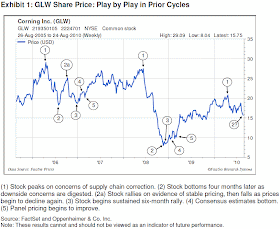
Morgan Joseph's Charles E. Mitchell Rentschler is making a BOLD call on N
avistar International (NYSE:NAV) lowering this target on the truck name
to $27 from $36 while reiterating his Sell rating.
(Mind you, this is a $50 stock.)
Here are the details:
EGR Starts with "E"...as in Edsel
To the best of our knowledge, Navistar isn't making many more of its new engines than it was a couple of months ago. Using our trusty cars-in-the-parking lot "leading indicator" — we calculated last Friday (8/6/10) that there were 80-90 employees at the Huntsville MaxxForce 13-liter (actually 12.4) plant, which we believe translates into production of around 40 engines per day.
Our estimate triangulates with the Ward's report for July (the first month that NAV was bereft of 2007 CMI engines) of about 800, which also happens to suggest production of about 40 engines per day. This works out to an approximate 7% share of the Class 8 business, versus Navistar's share for all of 2009 of 28%, a dramatic decline that should leave Navistar shareholders wanting some explanation from management, in our view. If we allow that a quarter of last year's production was 15-liter (which NAV is not making now), this implies the company has actually lost about 67% of its 13-liter business (14/21).
Navistar's apparent significant market share loss is certainly not due to a decline in overall demand within the industry, which is strengthening (e.g., trade chatter is that Freightliner, belonging to Daimler-Benz, is sold out of its leading Cascadia model through the rest of 2010). But Navistar's loss could be the result of supply issues and/or quality problems; or it could be, as we believe, that truckers simply aren't buying the concept of EGR, which is inherently less fuel-efficient, not EPA-compliant, and not fully tested, in our opinion, and that it could experience serious warranty and reliability problems, in our view: In a word, an Edsel. We note that informed people in the industry we talk to (admittedly few have even seen a MaxxForce 13) are highly skeptical that it will fly.
Oh, to be Vertically-Integrated!
Almost everyone within the industry understands the urge to be vertically-integrated ("getting out of the nest"), which is, in our opinion, best done over time and with contingency plans, however...that's not the case with Navistar given there were no parallel paths or plans put in place, to our knowledge. Once all of the CMI 2007-certified engines were depleted, Navistar was on its own. SCR engines, with all of their paraphernalia, require far more truck-space and part-numbers. So, the SCR-ready tractor is substantially different from the EGR-ready tractor – meaning that it would take some time for Navistar to re-engineer its chassis to take SCR, if this is what Navistar chooses to do.
We understand, after speaking with one of our reputable industry sources, that, in fact, Cummins and Navistar are now jointly testing a Navistar ProStar truck with a Cummins SCR 15-liter (actually 14.9) diesel. The problem is, it was also suggested that it won't be ready for 4-6 months...after Navistar has agreed to this approach, which implies an effective start-time of around February 1, more or less, we think. But will Navistar's management actually do an about-face?
The Abyss, as an Alternative
If the company, on Tuesday, does not acknowledge it is peering into a gaping chasm as a result of its precipitous choice of EGR for 2010 engine technology, in our opinion, then all bets are off. Certainly, our estimates for 2010 and 20111 would be rendered "null and void." We'll try to divine the thrust of this scenario that afternoon, if necessary.
Rentschler's new estimates are for $0.50 for fiscal 3Q (ended 7/31) and $0.80 for fiscal 4Q (ending 10/31), revised down from $0.80 and $1.55, respectively, which translates into $1.95 for fiscal 2010 (down from $3.00 previously); he has also lowered his fiscal 2011 EPS estimate to $2.25, from $3.00 previously
The company has been guiding for $2.75-$3.25 for this year (no guidance provided, yet, for F2011), while the prevailing Street consensus is for F2010 EPS of $3.07 and F2011 EPS of $5.14.
These estimates assume Navistar stops building EGR motors ASAP and starts buying SCR engines from Cummins Inc. (CMI - $81.13 - NYSE; Buy), which suggests the company can begin to turn things around by February 1, 2011, or by Navistar's second fiscal quarter of next year.
Notablecalls: Once this call starts circling the desks, I think NAV will get hit.
Look at the chart.








